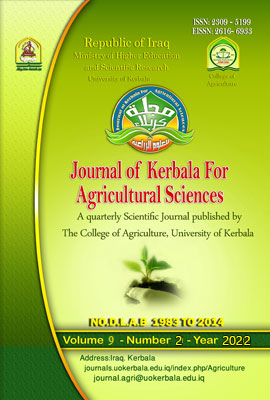Physical control of the Lesser Grain Borer Rhyzopertha dominica (Coleoptera: Bostrychidae) using various microwaves levels
DOI:
https://doi.org/10.59658/jkas.v9i2.962Keywords:
Lesser Grain Borer, Physical control, microwavesAbstract
This study was conducted in the year 2022 at the Department of Plant Protection, College of Agricultural Engineering Sciences, to evaluate the effect of microwave rays on various stages of the R. dominica. Microwaves of 220, 420 and 620 Watts at 30, 60 and 90 seconds effects on eggs, 4th instar larva, Pupas and adults were evaluated. The highest egg mortality was at 620 Watts for 60 seconds. Exposure to 620 Watts for 30 seconds increased the hatching period from 7.0 days for the control to 10 days 4th. Instar mortality was 100% at 620 Watt for 90 seconds. Pupae and adults 100 % mortality achieved at exposure to 620 Watts for 60 and 90 seconds, respectively. Generally, various stages of the R. dominica mortality increase by increasing the wattage and exposure time.
Downloads
Published
How to Cite
Issue
Section
License
Copyright (c) 2022 Copyright (c) 2024 is the Author's article. Published by the Journal of Kerbala for Agricultural Sciences under a CC BY 4.0 license

This work is licensed under a Creative Commons Attribution 4.0 International License.
Licensing Terms
All articles are published under a Creative Commons License and will be directed to the Creative Commons Attribution 4.0 International License (CC BY 4.0) That permits use, distribution, and reproduction in any medium, provided the original work is properly cited. This license also allows the work to be used for commercial purposes.
Use by both non-commercial and commercial users
This content is licensed under a Creative Commons Attribution 4.0 International (CC BY 4.0) license, permitting use by both non-commercial and commercial users. Individual users may access, download, copy, display, and redistribute the articles to colleagues, as well as adapt, translate, and text- and data-mine the content, subject to the following conditions:
- The author's moral rights, including the right of attribution and the right to protect their work from derogatory treatment, are respected.
- Where content in the article is identified as belonging to a third party, users must ensure that any reuse complies with the copyright policies of the owner of that content.
- If the article content is reused for research or educational purposes, users should maintain a link to the appropriate bibliographic citation, including the DOI and a link to the published version on the journal's website.

